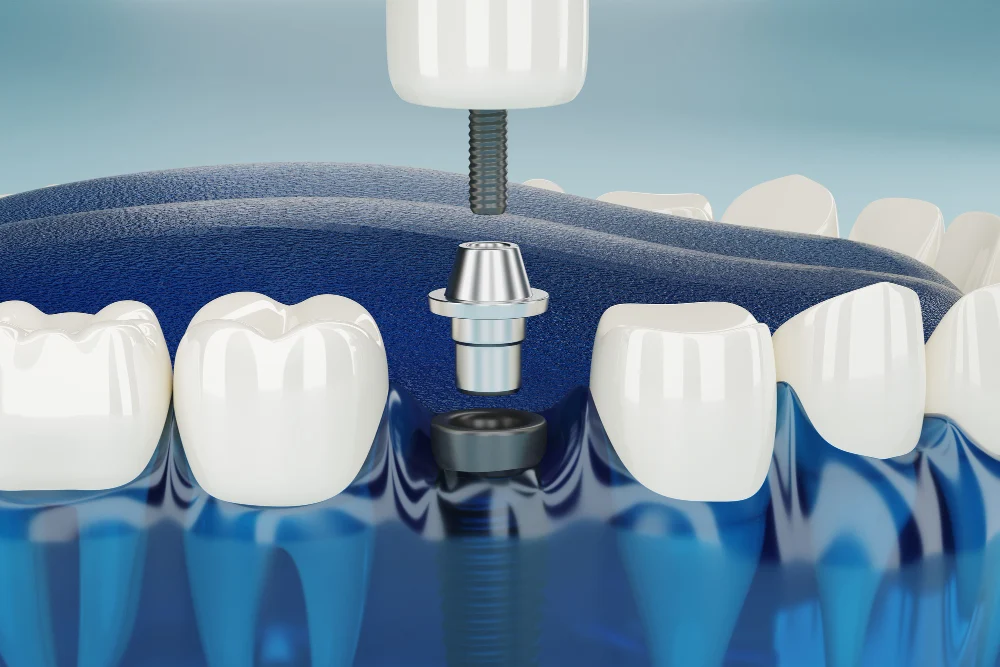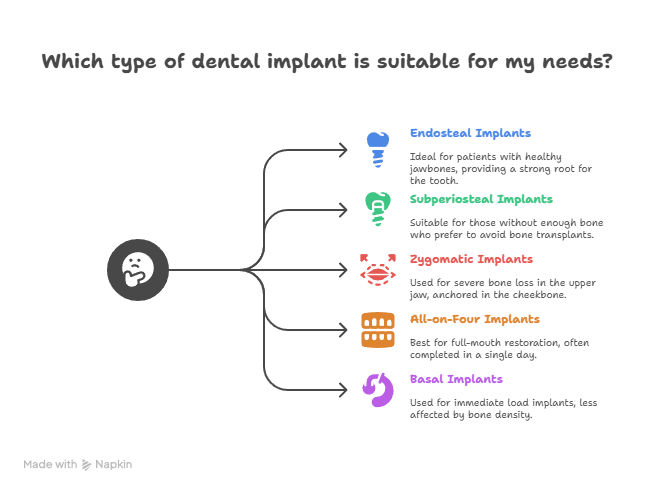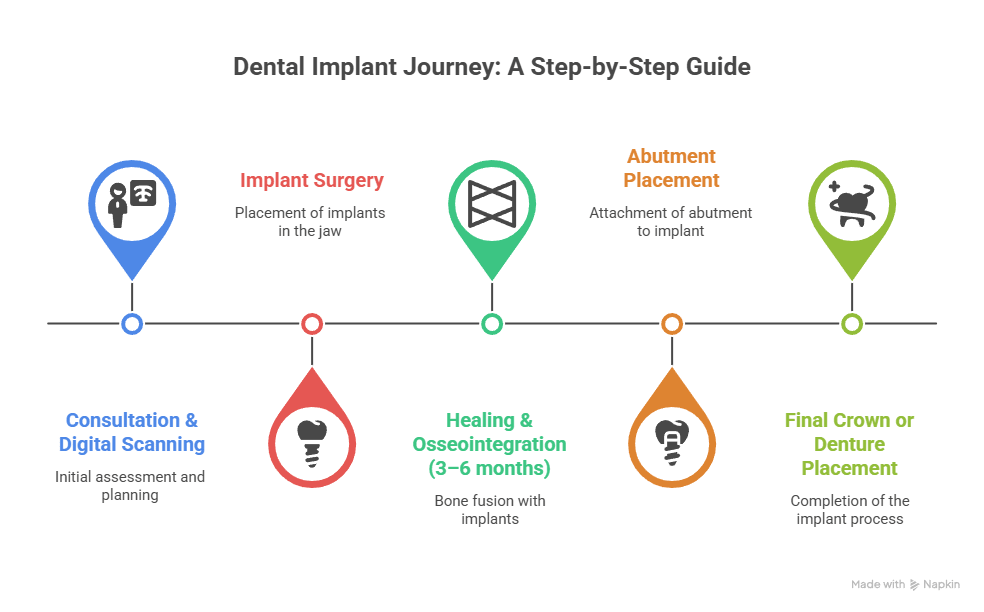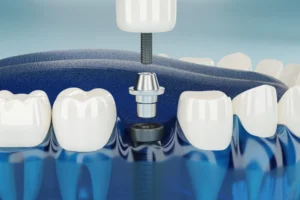Missing a tooth (or several) can mess with your confidence, your speech, and even your favourite foods. This complete dental implants guide walks you through everything you need to know, how implants work, who they’re for, and what recovery is like. If you’ve been curious, this guide to dental implants makes it all easy to understand.
Key takeaways:
- Dental implants are titanium roots placed into the jaw to support artificial teeth
- They provide long-term durability, comfort, and natural appearance
- There are multiple types: Endosteal, Subperiosteal, Zygomatic, All-on-4, and more
- The procedure involves consultation, surgery, healing, and final crown placement
Missing teeth affect not only your smile but also the way you talk and your eating habits. They can even affect your confidence in daily life. Here comes the importance of dental implants.
They are not only able to bridge the gap, but they also become part of your mouth and function exactly like natural teeth. In this complete guide to dental implants, we will explain everything in an easy and understandable language to you: their nature, their intended users, the entire procedure, and the post-treatment process.
If you’re thinking about implants or just curious, this step-by-step guide and expectations article will help you be completely clear on what is going to happen to you.
What Are Dental Implants?

Dental implants are titanium-based artificial tooth roots, and they are implanted surgically into your jawbone to support crowns, bridges, or dentures. They slowly fuse with bone through a process known as osseointegration that makes them indistinguishable from the real ones, thus allowing you to use them like real teeth.
Their role is similar to that of anchors in the case of your new teeth. Once the healing process is over, they provide you with the same functionality that you had before, i.e. to be able to chew, speak clearly, and smile confidently. Dentures can be loose, and still, implants are secure and strong. They are a solution for the long run that does not rely on other teeth for support.
They have become one of the most reliable and natural replacement solutions available. With proper care, dental implant procedures can last for decades or even a lifetime. If you’re exploring options for missing teeth, this guide to dental implants can help you understand why they’re such a long-term and dependable solution.
Why Dental Implants Are the Best Long-Term Solution
Dental implants are often chosen over bridges or dentures, and here’s why:
- Look and feel natural: Most cannot make a difference between a transplant and a real tooth.
- Last for decades with proper care: When bones merge, implants rarely fail.
- Prevent bone loss and preserve facial shape: Loss of teeth causes shrinkage of the jaw over time. Implants stop that.
- Improve chewing, speech, and confidence: No more worries about slipping or falling out of teeth.
This is a mixture of aesthetics, comfort, and functionality that makes dental implants the top option for many people. For those considering this treatment, this detailed dental implants guide can offer valuable insights into the benefits and process involved.
Are You a Candidate for Dental Implants?
Not everyone is ready for transplantation immediately, but many people can qualify with the right preparation. You’re a perfect candidate if:
- You’re missing one or more teeth
- Your gums are healthy
- You have enough bones to catch the implant, or you are ready to undergo a bone transplant
- You’re not a smoker, or you’re ready to quit
- If you have diabetes or another medical condition, it is managed and under control
In case you are considered a good candidate for a dental transplant, your dentist will perform a thorough check to decide. However, if you are not instantly suitable, procedures like bone grafting or a sinus lift can make the transplantation possible. This comprehensive guide to dental implants will also explain the steps in detail to help you feel more informed.
Types of Dental Implants

Endosteal Implants
These are the most common types. A screw -like implant is directly placed in your jaw, and the replacement acts as a strong root for the tooth. They are beneficial for patients with healthy jawbones.
Subperiosteal Implants
They sit on top of the jawbone, but under the gums. If you do not have enough bones and do not want a bone transplant, they are an ideal option.
Zygomatic Implants (For severe bone loss)
These are anchored in the cheekbone (zygoma) instead of the jaw. They are used when there is significant bone loss in the upper jaw.
All-on-Four Implants (Full-mouth restoration)
This method is used only for implants to support entire teeth. It’s faster and can sometimes be done in a single day.
Basal Implants
The basal bone (the strongest part of the jaw) is placed deep, they are used for immediate load implants and is less affected by bone density.
Not sure which one’s right for you? This dental implants guide will help you figure it out, step by step.
Pre-Treatment Procedures & Custom Options

Before you get implants, the dentist may recommend other treatments to prepare your mouth:
- Sinus Lift / Sinus Enhancement: The sinus floor picks up to make room for transplants in the upper jaw.
- Ridge Augmentation: Adds bone to the jaw where it is very thin.
- Bone Grafting: The bone graft is added where it is missing or weak to support the transplant.
- Dental Implant Sizes: You can get mini implants for small spaces or standard size for the replacement of regular teeth.
- Molar Implants: They require large transplants due to high pressure from chewing.
- Abutments (Anchors): These are connectors located on top of the implant screw to hold the crown or bridge.
If all this sounds like a lot, don’t worry, this guide to dental implants will walk you through every step so you know exactly what to expect.
Step-by-Step Dental Implant Procedure & Timeline

Step 1 – Consultation & Digital Scanning
This includes dental X-rays or a CBCT scan to check your bone structure. The dentist will create a plan, outline the treatment process, and provide a cost estimate. If necessary, you will be referred to pre-surgical treatments like grafting.
Step 2 – Implant Surgery
Dental implants are placed in your jaw under local anesthesia. If you get more implants, it can all be done once or in steps.
Step 3 – Healing & Osseointegration (3–6 months)
The bone fuses with the implant during this time. You might get a temporary tooth to wear while healing happens. Most people return to work in 1–2 days.
Step 4 – Abutment Placement
Once healing is done, the dentist opens your gum to attach an abutment to the implant. In some systems, this step is combined with the original implant surgery.
Step 5 – Final Crown or Denture Placement
Your dentist takes the impression to make a tailor-made crown or denture that fits completely in your mouth. It’s fixed to the abutment, and you’re done!
What to Expect: Healing, Risks & Side Effects
Right after the surgery, it’s normal to feel:
- Mild pain or discomfort
- Swelling near the gums or face
- Minor bleeding
- Bruising
Your dentist can give you painkillers or antibiotics. Stick to soft foods and avoid touching the area when healing.
Risks include:
- Infection
- Nerve damage (tingling or numbness)
- Implant movement or failure
- Sinus issues (if implants are placed near the upper jaw)
These problems are rare, especially with the right plan and guided surgery.
Aftercare & Maintenance Tips for Dental Implants
Daily care matters for long-term implant success. Here’s what to do:
- Brush gently with a soft toothbrush twice a day
- Clean between teeth using floss or water flossers
- Use an antibacterial mouthwash when recommended
- Visit the dentist every 6 months for a checkup
If you grind your teeth, talk to your dentist about wearing a night guard. And definitely quit smoking – it slows the treatment and increases the transplant failure frequency.
Bonus Tips for Long-Term Oral Health
Do not chew sticky foods, hard candy, or ice cream. Additionally, you also limit the consumption of products that can stain your crown, such as coffee or red wine. Follow your daily dental routine and go for regular dental checkups.
Cost of Dental Implants
Price Range
- Single Tooth: ₹25,000–₹60,000
- Full Mouth: ₹2.5L – ₹6L
What Affects the Cost?
- Number of implants required
- Grafting or sinus lift needs
- Materials used (Zirconia vs. PFM)
- Dentist’s skill and experience
- Location and facilities at the clinic
Flexible Payment Options
- 0% EMI options at many dental clinics
- Third-party medical financing or loans
- Some insurance plans may cover parts of the procedure
Always ask if your quote includes CBCT scans, temporary teeth, and follow-up appointments.
Bonus: How Technology Improves Implant Accuracy
Modern clinics often use guided implant surgery. It uses digital scans and 3D-printed surgical guides to make the process more accurate.
Benefits:
- Smaller incisions and faster healing
- Better alignment with less chance of error
- Saves chair-time
- Reduces discomfort and improves outcomes
Technologies like intraoral scanners and digital impressions also make the process faster and more comfortable.
Why Choose Us for Dental Implants
You deserve care from someone who knows their stuff. Here’s what makes our clinic different:
- In-house digital scanning & planning
- Transparent, affordable pricing
- 0% EMI and flexible payment options
- 100+ happy patients with real before-and-after results
We don’t believe in shortcuts. Just honest, high-quality treatment you can count on.
We don’t do quick fixes. We focus on long-term, high-quality care that actually lasts — all backed by the expertise of Dr. Tarun Kumar A B (BDS, MDS, FICOI, DICOI – 25+ years of implant experience) and Dr. Rashad Nazeer (BDS, FICOI – 6+ years of implant experience).
Book a Free Dental Implant Consultation Today
- Get a personalized treatment plan
- No hidden costs
Let us help you get your smile back. Whether you are ready to start or just look for options, we are here to answer your questions.
Conclusion
In this guide to dental implants, we outlined how implants are placed, how they heal, and why they outperform dentures or bridges. When done properly, dental implants offer unmatched comfort and longevity.
Trust Hashtag Smile to deliver world-class implant care backed by experience, empathy, and results. Book your free consultation today and take the first step toward a secure, beautiful smile.
FAQ
Q: Are dental implants painful?
You may experience some minor discomfort for two or three days. But most people say that it is less painful than tooth extraction. Painkillers and rest help reduce the pain.
Q: What are the risks or side effects of getting implants?
The side effects of getting implants include infection, nerve damage, or implant failure. But with proper planning and aftercare, you can avoid such risks.
Q: Are dental implants suitable for everyone?
Most healthy adults are candidates. If you have diabetes or bone loss, your dentist may guide you in the next stages, like bone grafting or controlled healing.
Q: How long do dental implants last?
Transplants can last for 20 years or more, often for the rest of their life. However, maintaining good oral hygiene and scheduling regular checkups are essential.





